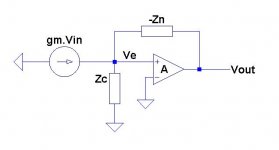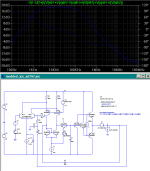It looks like discreet bipolars are second best to JFETs, better than op-amps.
However, when space is restricted, op-amps may be the only option.
However, when space is restricted, op-amps may be the only option.
PMA said:When BJT diff pairs degenerated enough, they are very good.
JC says that not as good as JFETs … (if I understand him correctly).
John, I didn't say use only JFETs, I said that according to you (if I understand you correctly), JFETs are better. Or am I wrong?
john:
just curious to know if there was any positive impact in your test results after hanging a current sink on the back of the ad797 (or any of the others). i'm guessing if you tried the the opa827 and lt1468, the results were as undesirable as the others in your list?
(no slight to scott intended)
is minidip package a requirement for your application also?
mlloyd1
just curious to know if there was any positive impact in your test results after hanging a current sink on the back of the ad797 (or any of the others). i'm guessing if you tried the the opa827 and lt1468, the results were as undesirable as the others in your list?
(no slight to scott intended)
is minidip package a requirement for your application also?
mlloyd1
john curl said:....Today I tried the 711, 817, 411, and 797. All pretty bad, even at 1KHz....
Joshua_G said:John, recently I purchased few hundreds of them. For now, they are still available.
It’s no problem to buy fakes. You can get them for next to nothing.

There are singles still available, BUT we are talking production quantities. Please, Joshua, we know what we are doing.
Of course, Joshua, but realize that both PMA and I have to be practical, sometimes. Ideal at other times. Fet's have an intrinsic advantage over heavily resistor laden emitter bipolar pairs in both simplicity and noise. However, for a line amp, this is of little problem.
It is a little like my Porsche: I have owned and driven 4 cylinder engines of various manufacture: French, English, Swedish, German and Japanese, for 49 years, yet I know that a Porsche 959, Boxster, and 911 with their 6 cylinder engines are superior, EVEN with the same displacement. I will continue to drive my 4 cylinder cars, because they are practical for me. It might hurt my feelings if someone criticizes my 4 cylinder cars as inferior in some way. For my needs, and expense account, this works. However, my newest business partner drives a Boxster, the other, a Mercedes and a Bentley,and the other a BMW. Hardly a 4 cylinder car in the bunch!
It is a little like my Porsche: I have owned and driven 4 cylinder engines of various manufacture: French, English, Swedish, German and Japanese, for 49 years, yet I know that a Porsche 959, Boxster, and 911 with their 6 cylinder engines are superior, EVEN with the same displacement. I will continue to drive my 4 cylinder cars, because they are practical for me. It might hurt my feelings if someone criticizes my 4 cylinder cars as inferior in some way. For my needs, and expense account, this works. However, my newest business partner drives a Boxster, the other, a Mercedes and a Bentley,and the other a BMW. Hardly a 4 cylinder car in the bunch!
Luckily I don't have to be that practical for making 1 unit.
I try to attain the best sound I can possibly get.
My main compromise will be the case, as I cannot afford milled aluminum …
However, I try to make as little compromise as I can with parts selection, though I'll probably skip Teflon capacitors.
I try to attain the best sound I can possibly get.
My main compromise will be the case, as I cannot afford milled aluminum …
However, I try to make as little compromise as I can with parts selection, though I'll probably skip Teflon capacitors.
cliffforrest said:You must be in the UK with that kind of plumbing nightmare!
Mixing Cu and plastic fittings is a nightmare!
I still use the cheapest solderable fittings ...
I've always lived in Victorian or Edwardian flats and houses in the UK. Here you can find any combination of copper, steel, lead and plastic piping. Sometimes all four coexist in the same property! Steel is a pain because it requires a monkey wrench. Lead is a nuisance because it can crack and although it is simple to melt the crack away with a blow torch, doing so is illegal and the faulty pipe section must be replace with a new pipe material with special fittings designed to mate with lead. Cu is robust and cheap but time-consuming. I like plastic stuff because it is quick and flexible, but it must be used with at least the competence to put in the inserts. Not too much to ask.
scott wurcer said:Jeez, I flipped the sense. The currents all add up the same way though. I hope this does not confuse anyone.
Yes, the currents add up for the same result. Thanks Dimitri.
Dimitri's diagram makes more sense to me. If I simplify the AD797 further I get this:
Attachments
My question to you, Scott, is what choice of Zn, Zc and A make this a FB circuit, if any, and which do not. That is the crux of my challenge to your earlier rejection of the FB label.
Brian
Brian
Not shown in the diagrams. This is the matter at hand - the means by which the output buffer feeds a correcting signal back to the current mirror.scott wurcer said:Traderbam,
<snip>
I hope it’s clear that the output buffer supplies the current that is mirrored so that the input stage still needs exactly the same +-5uA to make 10V at the output i.e. the voltage transfer function of the output stage has no net error back at the input gm so that the global feedback does not see it. Please forgive that I rounded 1 1/9 to 1.1.
A little righteousness crept in there.Yes, if you want to consider a current mirror as a feedback circuit then you could argue such. These arguments like, “an emitter follower is feedback”, don’t send circuit design, as an art, forward.
 In this context a current mirror is not a FB circuit, nor is an emitter follower. I am not saying that. Their transfer functions are not the same as the loop transfer function through Cn.
In this context a current mirror is not a FB circuit, nor is an emitter follower. I am not saying that. Their transfer functions are not the same as the loop transfer function through Cn.I feel an urge to ask you how you distinguish between feedback and "subtractive neutralization" in a mathematical sense. I find textual descriptions are generally hard to interpret without ambiguity. 🙂
Brian
HI Brian,
I've taken jcx's approximate AD797 simulation and made a few modifications to it. I blocked all the global feedback by putting a 1e10 Henry inductor in series with the feedback resistor from output to inverting input, and a 1 Farad cap to ground on the non-output side of the inductor. Then I put a loop gain probe inside the "neutralization loop". Here's the schematic and loop gain plot.
I've taken jcx's approximate AD797 simulation and made a few modifications to it. I blocked all the global feedback by putting a 1e10 Henry inductor in series with the feedback resistor from output to inverting input, and a 1 Farad cap to ground on the non-output side of the inductor. Then I put a loop gain probe inside the "neutralization loop". Here's the schematic and loop gain plot.
Attachments
- Status
- Not open for further replies.
- Home
- Amplifiers
- Solid State
- John Curl's Blowtorch preamplifier

